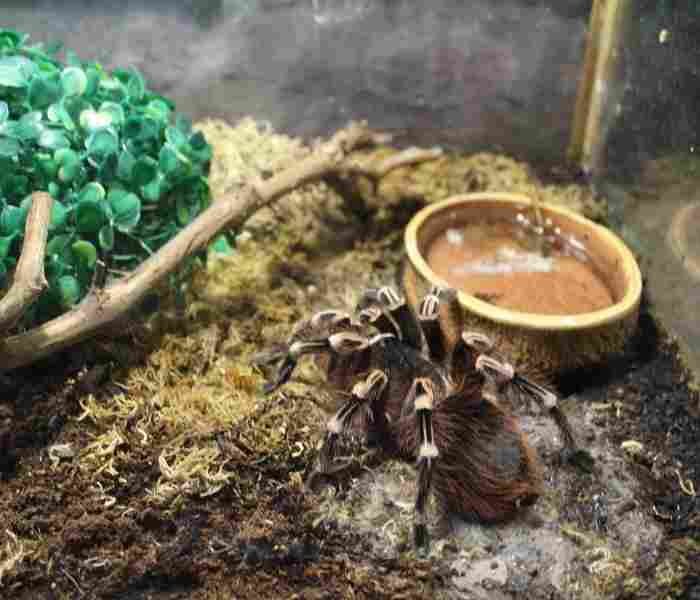Tarantulas are one of the most popular pets in the world and for good reason! These incredible creatures are not only fascinating to look at, but they’re also generally very docile, making them great pets for first-time arachnid owners.
If you’re thinking about getting a tarantula, there are a few things you should know first. In this guide, we’ll cover everything you need to know about raising a healthy and happy tarantula, including best tarantula enclosures, what to feed them, how to handle them, and more. Tarantula 101: guide to raising this incredible creature.
How Many Species Of Tarantulas Are Out There?
There are currently over 950 described species of tarantulas, with more likely to be discovered. Many of these species are yet to be formally described and named. Tarantulas can be found on every continent except Antarctica. The vast majority of tarantula species are found in the tropical regions of South America, Central America, and Mexico. A few species from Africa, Asia, and Oceania also exist. From burrowing species to terrestrial species and arboreal species; there is a lot to uncover.

Tarantulas are a widely variable group of spiders, with considerable variation in size, coloration, and habitat preference. Some species grow to over 10 inches (25 cm) in length, while others are less than an inch (2.5 cm). They can be brown, black, tan, or even bright colors.
Can All Tarantulas Be Pets?
Despite their reputation, not all tarantulas are aggressive or venomous enough to make good pets. In fact, several different species of tarantula can be kept as pets, provided you do your research beforehand and take the necessary precautions. The most common tarantula species that make for good pets are the Chilean rose, the Mexican red knee, and the Goliath birdeater. With the right tarantula enclosures, these creatures will thrive.
Tarantula 101: Guide To Raising This Incredible Creature And Tips For Buying A Tarantula Pet
Do your research: make sure you know what kind of tarantula you’re interested in and what kind of care it will need. There are many different species of tarantulas, and they all have different requirements.
Find a reputable breeder or dealer: buy from someone who knows what they’re doing and can provide you with healthy, well-cared-for animals.
Be prepared to provide the proper housing and care for your new pet: tarantulas are not easy to care for, and they will need a dedicated tarantula enclosure with the appropriate temperature, humidity, and ventilation. They also need a diet of live insects.
Housing Your Tarantula

The best tarantula enclosures are those that are escape-proof, well-ventilated, and offer the appropriate level of humidity for your particular species. They should feel like a natural habitat. Tarantula keepers must provide a proper feeding dish for the exotic pets. Tarantula owners may opt for acrylic enclosure or tarantula cages. The best tarantula enclosures must accommodate leg span. Acrylic enclosures or glass enclosure should be designed precisely for terrestrial or burrowing species.
They need a hiding place in their tarantula enclosure, so be sure to include a hide or two. Whether you have a terrestrial species or arboreal species, ventilation holes and feeding holes are key. Other features are potting soil, front window ventilation mechanism for proper ventilation, escape proof dual locks and more.
Arboreal tarantula enclosures are typically tall and narrow, while terrestrial tarantulas can be kept in shallower, wider enclosures. It’s important to make sure that your tarantula has enough room to move around and that its enclosure is escape-proof. Arboreal and terrestrial tarantulas can make great pets as long as you provide an ideal tarantulas enclosure or tarantula cage.
The best tarantula enclosures for arboreal tarantulas and terrestrial tarantulas must be just right. An arboreal tarantula enclosure must consider leg span for the perfect tarantula enclosure. To this end, an arboreal terrarium is a taller enclosure.
The best tarantula enclosures may have stainless steel mesh cover for the arboreal or terrestrial species. The stainless steel mesh cover protects larger enclosures.
The substrate (materials used to line the bottom of the enclosure) should be something that can hold moisture, such as sphagnum moss or coco coir.
The ideal enclosure has enough space, cross ventilation for the tarantula’s species. Pet owners should have a habitat kit with a few accessories like a substrate heater, lighting system, hinged door with good locking mechanism, custom designed feeding ports and more. Double the leg span for the arboreal spider.
The best tarantula enclosure for terrestrial tarantulas should have a solid bottom that cannot be easily tipped over, such as a glass aquarium.
Temperature and Humidity
Tarantulas come from tropical climates and therefore need warm temperatures and high humidity levels. The ideal temperature range for most tarantulas is between 75 and 85 degrees Fahrenheit (23 to 29.5 Celcius), with a humidity level between 60 and 80%.
Your tarantula’s enclosure should have a heated basking area on one end and a cooler area on the other. This temperature gradient will allow your tarantula to regulate its own body temperature by moving between the two extremes as needed.
You can create a basking area by using a heat lamp, ceramic heat emitter, or under-tank heater. The basking area of the tarantula enclosure should be about 10 degrees warmer than the cooler side of the enclosure.
Use a digital thermometer and hygrometer to monitor humidity levels and temperature inside your tarantula’s enclosure.
You can find excellent tarantula cribs for under $100. Just make sure to do your research before you buy one! Professional tarantula cribs are enclosures that provide everything your tarantula needs to stay healthy and happy. They include a water dish, hiding places, ventilation, and sometimes even plants or other decorations. A good tarantula crib will last for years and provide your pet with a comfortable home.
If you’re looking for a more affordable option, there are plenty of DIY tarantula cribs available online. Just be sure to do your research before you start building, as there are some important considerations to keep in mind. Tarantulas need a warm, humid environment, so make sure your tarantula enclosure can meet those needs. Ventilation is also crucial, as tarantulas are susceptible to respiratory infections. With a little bit of planning, you can easily create a safe and comfortable home.
In a nutshell, to have a happy pet spider, a tarantula enclosure or crib must be provided with the following items:
A hiding place – Spiders like to have a place to hide away from the light and activity in their enclosure. This can be something as simple as a hollowed-out log or a cardboard box with a hole cut in it.
Climbing surfaces – Tarantulas will often climb up the sides of their enclosure to get a better view or to find a more suitable hiding spot. Providing some smooth rocks, sticks, or branches for them to climb on will help keep them happy and healthy.
Water bowl – A small water bowl should be provided for your spider to drink from. Be sure to clean and refill the bowl regularly.
Food – Your spider’s diet will consist mainly of live insects. You can purchase these from a pet store or breed them yourself. Be sure to offer a variety of different types of insects to keep your spider’s diet varied and nutritious.

How To Clean A Tarantula Crib
A tarantula’s crib can get pretty messy, especially if you have more than one. Clean enclosure regularly to keep your spider happy. It also helps in promoting good ventilation. Here’s how to keep it clean:
1. Remove all the old food and waste. This can be done by scooping it out with a spoon or using a small vacuum cleaner.
2. Wash the sides of the cage with a mild soap and water solution.
3. Wipe down the cage furniture and accessories with a moist cloth.
4. Allow everything to dry completely before putting it back in the cage.
5. Repeat this process every week or two to keep your tarantula’s home clean and tidy!
How To Feed A Pet Tarantula
Tarantulas eat live food, so you’ll need to find some small insects or rodents to feed your pet. You can purchase live food at a pet store, or catch it yourself if you’re feeling brave. Once you have your live food, simply place it in the tarantula’s enclosure and watch as it enjoys its meal. Just be sure to remove any uneaten food after a few hours to prevent it from rotting and attracting pests.
If you’re not comfortable with the idea of feeding live prey to your tarantula, you can also purchase frozen prey items that can be thawed and offered to your pet. This is often a safer option for both the tarantula and the owner, as there is no risk of escapees or injuries. Simply place the frozen food in the enclosure and wait for it to thaw before offering it to your pet.
No matter what option you choose, always wash your hands thoroughly after handling live or frozen prey, as some species can carry diseases that can be harmful to humans.
Tips To Handle Your Tarantula
If this is your first time handling a pet spider, you can be intimidated when it comes to handling and caring for the special creature. However, once you get used to them, tarantulas are sweet animals.
Below are top tips on handling your pet tarantula:
Wash your hands: Before you handle your tarantula, you must wash your hands. This will help to avoid the transfer of any bacteria or germs from your hands to the tarantula.
Be gentle: When handling your tarantula, be sure to do so gently. They are fragile creatures and too much force can injure them.
Support their body: When picking up a tarantula, be sure to support their entire body. Avoid holding them by their legs as this can cause them to lose a leg.
Put them back in their home: Once you are done handling your tarantula, be sure to put them back in their tarantula enclosure right away. They will feel more comfortable there and be less likely to escape.
Top Tarantula FAQs
How do you tell when your tarantula is unwell?
The most common sign that your tarantula is unwell is a change in behavior. If your tarantula normally is very active and suddenly becomes lethargic, or if it stops eating and drinking, these are both signs that something may be wrong. Other signs that your tarantula is unwell include changes in appearance, such as losing hair or shedding its skin more frequently than usual. If you notice any of these changes, it’s important to take your tarantula to the vet for a check-up. Always seek pet medical advice in advance.
What are the most common health problems for tarantulas?
Some of the most common health problems for tarantulas include mite infestations, bacterial infections, and fungal infections. Mite infestations can be treated with a variety of methods, including topical treatments, fumigation, and quarantine. Bacterial infections are typically treated with antibiotics, while fungal infections may require antifungal medication.
How can I prevent my tarantula from getting sick?
There are a few things you can do to help prevent your tarantula from getting sick. First, make sure to keep tarantula enclosures clean and free of debris. Second, provide your tarantula with a well-balanced diet that includes plenty of live food. Finally, avoid handling your tarantula too much, as this can stress it out and make it more susceptible to illness. If you do handle your tarantula, be sure to wash your hands thoroughly afterward.
Do tarantulas need to see a vet?
Yes, tarantulas should see a vet at least once a year for a check-up. This will help to ensure that they remain healthy and free of any potential health problems. If you notice any changes in your tarantula’s behavior or appearance, it’s important to take it to the vet as soon as possible.
How long do tarantulas live?
Tarantulas typically live for 10-20 years, although some species can live for longer. Male tarantulas tend to have shorter lifespans than females, as they often die soon after mating.
Do tarantulas bite?
Yes, tarantulas can bite, but their bites are usually not very harmful to humans. Tarantulas have fangs that deliver venom, but the venom is generally not strong enough to cause serious harm to humans. In most cases, the worst that will happen is some pain and swelling at the site of the bite. However, there are a few species of tarantula whose venom can cause more serious effects, so it’s important to be aware of which species you are dealing with.
What should I do if I’m bitten by a tarantula?
If you’re bitten by a tarantula, the first thing you should do is wash the area with soap and water. Then, apply a cold compress to the area to help reduce swelling. If you experience any severe symptoms, such as difficulty breathing or swallowing, seek medical attention immediately.
How many tarantulas can be kept in one tarantula crib?
There is no set number of tarantulas that can be kept in one tarantula crib, as it depends on the size of the crib and the size of the tarantulas. However, it’s generally recommended to keep no more than two or three tarantulas in one enclosure. This will help to prevent overcrowding and reduce the risk of disease.
What is the best type of substrate for a tarantula?
There are a variety of substrates that can be used for tarantulas, including sand, soil, mulch, and moss. The best type of substrate for your tarantula will depend on its species and needs. For example, desert-dwelling species will need a drier substrate, while rainforest-dwelling species will need a more humid substrate.
What type of food do tarantulas eat?

Tarantulas are typically carnivores, meaning that they eat other animals. In the wild, tarantulas typically eat insects, small mammals, and reptiles. In captivity, tarantulas can be fed a diet of live insects, such as crickets and mealworms. It’s important to offer a variety of different types of food to your tarantula to ensure that it gets all the nutrients it needs.
Do tarantulas need water?
Tarantulas do not typically drink water (or not very much), as they get all the moisture they need from their food and the environment in general. However, you do want to provide a shallow dish of water for your tarantula to soak in if it lives in a particularly dry tarantula enclosure and also to keep the humidity level up in your enclosure in general.
What is the molting process like for a tarantula?
The molting process can vary somewhat from species to species, but there are some commonalities. Tarantulas typically molt once or twice a year, and the process usually takes anywhere from two weeks to two months. During this time, the tarantula’s old exoskeleton will begin to loosen and split, and the tarantula will eventually emerge from it. The new exoskeleton is typically softer and more flexible than the old one, and it will harden over time. After molting, tarantulas are especially vulnerable to predators and should be kept in a safe, secure place.
Conclusion
A 2012 report from the American Pet Products Association estimated that there were around 7.3 million households in the US with at least one pet reptile, which would include tarantulas. These fascinating creatures are becoming more popular as pets, but there are still many people who are afraid of them. Tarantulas are not as dangerous as they seem, and can actually make great pets for those who are willing to take care of them.


